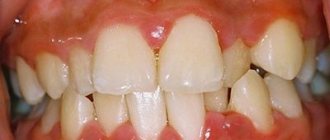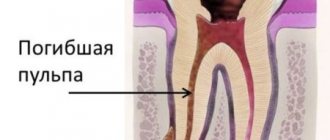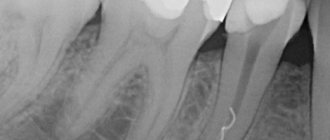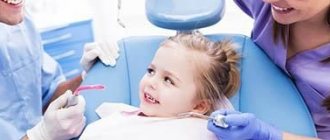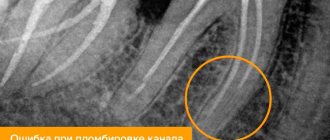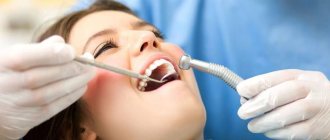Periodontitis is the term used by professional dentists to describe the inflammatory process of the very membrane of the tooth root and the adjacent soft tissues. The main cause of inflammation in this area is the penetration of pathogenic microflora from the dental canals in the upper part of the root. This route of infection is typical in cases of untreated or poorly treated caries. Less commonly, periodontitis occurs for other reasons.
Periodontitis is characterized by the following symptoms: throbbing pain, the intensity of which gradually increases and a clear localization of pain impulses in one specific area. Painful manifestations during periodontitis can intensify when eating food, closing the dentition and can be so intense and painful that a person is unable to eat or drink when they occur. Against the background of periodontitis, the general condition may worsen. To avoid negative health consequences, at the first suspicion of periodontitis, you should seek professional and high-quality treatment from a dentist.
Calculate the cost of treatment by taking a short test in 20 seconds!
Do not delay your treatment, because in this matter time plays against us.
However, it is useful to know that the symptoms of periodontitis may vary depending on the type of inflammation and its type. Further, in the material, we will consider in detail the forms of the disease, characteristic signs, as well as methods of treating periodontitis, which are used in modern dentistry.
Forms of dental periodontitis and their inherent symptoms
The two main forms of periodontitis are chronic and acute inflammation. Each type of disease has its own characteristic symptoms. For example, with acute periodontitis, intense and sharp pain impulses are noted, but bone tissue destruction does not occur. In chronic periodontitis, traditional signs of inflammation are most often absent, but on the x-ray, purulent saclike neoplasms formed in the upper part of the tooth roots will be clearly visible. Due to the formation of purulent cavities, the chronic form of periodontitis is also called granulomatous.
The treatment regimen for periodontitis is always selected based on the factor that initiated the onset of pathological changes, as well as its specific type. Remember that only a competent and qualified specialist can diagnose periodontitis and distinguish it from pulpitis, so do not engage in self-diagnosis and if you suspect periodontal inflammation - immediately contact our dentistry in Moscow - Vanstom. We are located in the center of Moscow, near the Baumanskaya metro station.
Diagnostics
To diagnose periodontitis, it is enough for an experienced dentist to examine the patient’s oral cavity. The presence of fistulous openings, inflammation of the gums around the tooth and the presence of symptoms typical of periodontitis will help to recognize the disease. To differentiate pathology from pulpitis and periodontal disease, use:
- X-ray of the tooth - the images will show rarefaction of the periodontium, the presence of a purulent focus, granuloma or cystic neoplasm at the root apex;
- CT is a more informative method of radiation diagnostics, which allows you to obtain a three-dimensional detailed image of the tooth and its surrounding tissues, on which the boundaries of periodontal inflammation will be visible, and its sources will also be determined.
Chronic periodontitis: treatment methods, cost
There is essentially one method of treating chronic periodontitis - the specialist will need to open the tooth before accessing the canal cavities, clean them of purulent contents, fill them, and after the patient has completed a course of antibiotic treatment, restore the natural crown part of the tooth with a permanent filling. However, the price for the treatment of chronic periodontitis can vary greatly depending on the number of canals in a particular tooth. The more there are, the higher the cost of the service.
The number of root canals in a dental unit may vary. Incisors and canines, lower premolars have only one canal, upper premolars have two canals. The chewing teeth have the largest number of dental canals. It can range from three to four channels per unit. When treating periodontitis, the dentist will need to treat and fill each of the canals of a particular tooth, so the larger the unit has canal openings, the higher the price of its treatment for periodontal inflammation. On average, the cost of a service for the treatment of chronic periodontitis can range from 8,000 to 10,000 rubles.
Please note that the indicated amount will only include procedures for treating canals and filling them, but restoration work to restore the functionality and aesthetics of a dental unit, as well as manipulations to unfill canals (if the tooth was filled previously) are considered separately. Therefore, the final cost of treatment for chronic periodontitis may increase by about 5,000-6,000 rubles. You can find out the full cost of periodontitis treatment by visiting the dentist’s office at our clinic in Moscow – Vanstom. We offer services of European quality at a reasonable and realistic cost!
Foreign bodies
Gutta-percha, paper pins, calcium residues and a wide variety of other things can be found in the periapical tissues.
The apical periodontium always reacts to foreign bodies. They can enter through the root canal, through an injured mucous membrane or periodontal pocket.
In the case of paper pin penetration, it should be remembered that the human body does not know how to process cellulose, so the foreign body is surrounded by a bacterial plaque, which maintains inflammation.
Gutta-percha is a biocompatible material. However, at the same time it can give a reaction from the apical periodontium. Studies in guinea pigs have shown that large particles of gutta-percha are encapsulated and surrounded by collagen fibers, while small particles support a local tissue reaction. And magnesium and silicon, which are contained in excess gutta-percha, can cause resorption.
Stages of treatment of chronic periodontitis
The nature of the inflammatory process during periodontitis may vary depending on its type, and the set of manipulations that a specialist will resort to for high-quality treatment of the disease will depend. Chronic periodontitis, according to the nature of the development of the inflammatory process, is divided into several types:
1. Fibrous periodontitis. With this form, patients are rarely disturbed by pain impulses, and there is no deterioration in their general condition. Minor pain can be observed only when immunity is reduced due to colds, as well as when there is a noticeable mechanical load on the area of the diseased tooth. Most often, fibrous periodontitis is diagnosed during an X-ray examination.
2. Granulomatous periodontitis, a feature of which is the formation of granulomas in the upper part of the dental root system - formations of a special kind that separate infected tissues from healthy ones. This form of the disease can also develop for a long time without revealing itself, but under the influence of certain factors it can develop into acute periodontitis. Therapy for granulomatous periodontitis can be either conservative or surgical.
The course of treatment for fibrous periodontitis is faster and easier than the granulating form of therapy. This is explained by the fact that with fibrotic inflammation of the periodontium, no significant pathological changes are observed in the upper part of the tooth root, and therefore dental canals can be filled during the second visit to the dentist.
Therapy for granulomatous periodontitis can take several months and during this time you will have to visit the dentist quite often. Below we will describe in detail all the stages of treatment of chronic forms of periodontitis.
Periodontal anatomy
The periodontium (from Latin perio - around, around; odontos - tooth) is a complex of tissues surrounding the tooth and holding it in the socket. It includes the gum, dental cement, alveolar bone, periodontal ligament, which is located between the dental root and the alveolar plate and communicates between the alveolar bone and the cement of the tooth root. The periodontium consists of many blood and lymphatic vessels, nerve endings, and periodontal fibers. The thickness of periodontal fibers depends on age and averages 0.2 mm, becoming thinner over the years. The periodontal ligamentous apparatus is represented by groups (bundles) of fibers that have different directions, connecting all areas of the periodontium into a single system, stretching between the teeth, from the cement of one tooth to the cement of another. The ground substance of the periodontium occupies about 60% and is an amorphous gel-like substance, 70% consisting of water. A large amount of base material and water in it are factors that play a huge role in providing shock absorption. A characteristic feature of the cellular structure of periodontal tissue is the ability for rapid renewal, but with age this process becomes slower. The structural integrity of the periodontium is ensured by the enamel attachment, the cells of which are completely renewed within 4–8 days. This ability to renew provides mechanical protection of the entrance to the marginal part of the periodontium and reduces the risk of negative factors affecting it. The periodontium performs the most important functions. Plastic – ensures the growth and development of teeth due to the activity of osteoblasts and cementoblasts; trophic – provides nutrition to the cement base of the tooth and the alveolar plate; supporting-retaining – ensures fixation of the tooth in the alveolus; shock-absorbing - distributes chewing pressure due to the ligamentous apparatus; protective – prevents the entry of pathogenic microorganisms and the spread of inflammatory processes 3.
Inspection and primary treatment of dental canal cavities
Treatment of periodontitis begins with a thorough examination of the patient by a dentist, after which the specialist prescribes an x-ray for the patient. The image will help make the diagnosis as accurately as possible, as well as study in detail the number of dental canals, their length and shape. Next, an anesthetic injection is made into the area of the diseased tooth, without which treatment of periodontitis can be a very painful and uncomfortable process for the patient.
After the drug takes effect, the doctor will perform the following manipulations:
- It will remove from the diseased dental unit all tissues damaged by the carious process, as well as some healthy enamel and dentin. This is necessary to gain access to the mouths of the dental canals;
- If the tooth has not been treated before, the doctor will remove the inflamed pulp from it. If treatment of the unit with the removal of nerves has previously been carried out, the tooth canals are unfilled;
- Expand the tooth canals manually, using specialized instruments for this purpose. After expansion, the tooth canals are thoroughly washed with an antibacterial solution;
- Place a medicine with enhanced antiseptic action into the channels.
After applying the antiseptic to the dental unit, a temporary filling is installed, and the specialist thoroughly advises the patient on oral care, prescribes anti-inflammatory drugs and medications that reduce the risk of allergic reactions. The next time you will need to visit the doctor approximately three days after completing the first stage of periodontitis treatment.
Temporary filling
During a second visit to a dentist-therapist during the course of treatment of chronic periodontitis, the area of manipulation is examined. The specialist will also clarify whether the patient has any complaints of pain, swelling in the gum area or other discomfort. If such negative phenomena are not observed, temporary filling of the dental canals is performed.
For this purpose, the temporary filling is initially removed, as well as the antiseptic placed in the tooth canals. The canal openings are thoroughly washed with an antiseptic and then filled with a special type of composite material used for temporary filling. This composite contains calcium hydroxide, a substance that destroys pathogenic microflora and also catalyzes the process of bone tissue regeneration in the area of the upper zone of the tooth root. Temporary filling of canal cavities is done for a fairly long period - from two to three months. The dentist then places a temporary filling in the crown of the tooth.
Permanent canal filling
Permanent canal filling in the treatment of periodontitis is performed during the third visit to the dental office. Before proceeding with any manipulations, the specialist sends the patient for a control x-ray. The image will help determine the effectiveness of periodontitis treatment. If the percentage of bone tissue destruction has decreased significantly, permanent filling of the canals is performed.
The procedure begins with the removal of the temporary filling from the crown of the tooth, and then the canals are freed from the previously placed composite. The doctor will carry out an antiseptic rinse and then fill them to the apical part of the root with a composite. Upon completion of the work, the patient is given another x-ray to monitor the quality of the filling performed. Gutta-percha must be tightly packed into the canals to the very apex of the root, otherwise there is a high risk of relapse of periodontitis.
A couple of days later, the patient comes to the doctor for the fourth time and during this visit the crown part of the tooth is restored with a permanent filling to restore its aesthetics and functionality.
Urgent medical care for the treatment of periodontitis
When providing emergency care to a patient during the treatment of periodontitis, the first step is to open the diseased dental unit to create an outflow of purulent contents that have accumulated in the apical zone of the root. If swelling of the gums is observed against the background of acute periodontitis, an incision is made.
The patient will have to walk with the exposed tooth for several days, after which he must visit the dentist again. During this entire period, when eating or drinking drinks, it is extremely important to cover the exposed dental unit with a cotton swab and remove it after the meal - this will prevent clogging of the canals with food debris and a possible relapse of the inflammatory process.
The emergency stage of treatment of acute periodontitis is a service that is affordable in terms of price. Its average cost ranges from 2000 to 2500 rubles. However, it is important to understand that the treatment of periodontal inflammation does not end there and it must be continued.
After the procedure of opening a tooth in the treatment of periodontitis, the patient is prescribed a course of antibiotics, rinses with antibacterial solutions, as well as anesthetics and antihistamines.
Calculate the cost of treatment by taking a short test in 20 seconds!
Do not delay your treatment, because in this matter time plays against us.
Prevention
The risk of the occurrence and development of periodontitis can be minimized if you follow simple simple recommendations from dentists that are suitable for most clinical cases:
- Brush your teeth at least twice a day. In this case, you should avoid hard brushes so as not to injure your gums.
- After each meal, you must rinse your mouth - with a special mouthwash, or with warm boiled or filtered water.
- Try to use toothpicks less often to clean the space between your teeth - they can unnoticed injure the periodontal pockets and lead to the risk of inflammation. It is much safer and more effective to use dental floss for these purposes.
- Visit your dentist regularly for preventive care (at least twice a year) - a scheduled appointment allows you to identify most diseases in the early stages and avoid serious consequences.
- At least once a year (or better yet, twice) undergo professional cleaning and remove tartar, because even a slight plaque can lead to the appearance of pathogenic bacteria in the oral cavity.
- Try to give up bad habits. Smoking and alcohol inevitably lead to deterioration of dental health, as well as loss of their attractiveness and natural whiteness.
Temporary and permanent root canal filling
After the operation to remove pus for acute periodontitis, 3-4 days should pass, and then the patient visits the clinic again. During the second appointment, the doctor performs the following manipulations:
1. Thoroughly rinses the canal cavities with antibacterial solutions, and then puts an antiseptic in them.
2. Places a temporary filling on the tooth.
The patient is sent home, but is warned: at the slightest sign of pain, he should immediately seek professional dental care.
Permanent filling of the canals is carried out during the third visit. The treatment procedure can be carried out in the absence of complaints from the patient about any discomfort, as well as in the complete absence of pus in the canal cavities. The canals are filled with gutta-percha composite to the upper root zone. Restoration of the aesthetics and functionality of the tooth is done on a subsequent visit, and at this point the course of periodontitis treatment is considered complete.
Symptoms of the disease
General symptoms depend on the form of the pathology. When granulomas form, attacks of pain are observed when exposed to hot food. Pressure on the affected tooth and gum is accompanied by pain. The size and density of the mucosa in the affected area changes, and a granuloma forms under the bone or mucosa.
An exacerbation is accompanied by the appearance of fistulas, which grow and gradually release their contents into the oral cavity. In this case, purulent fistulas can appear not only on the gums, but also on the cheekbones, cheeks, neck, and chin. Isolation of pus may be performed along with the isolation of granulosa tissue. Then the fistula goes away, and a scar appears in its place.
The granulomatous form occurs for a long time without pronounced symptoms. Only after the granuloma grows to a large size and cysts form, the main symptoms appear: discoloration and severe pain in the tooth, development of gumboil and swelling of the gums in the affected area. Cysts that are too large can cause a jaw fracture and long-term rehabilitation.
Fibrous periodontitis is the most hidden form of pathology. There is no pain when chewing food or drinking hot drinks. Severe symptoms are observed only during exacerbation. There is general poisoning of the body due to the penetration of pus into the blood, the tooth becomes loose, and the lymph nodes in this area become larger.
Is it possible to cure periodontitis on your own?
It is important to understand that treatment of such a serious disease as periodontitis simply cannot be carried out at home. It is impossible to relieve inflammation either with pharmaceutical drugs, much less with decoctions, tinctures, or rinses according to traditional medicine recipes. Even if you start taking antibiotics on your own, periodontitis cannot be cured, since the source of the disease is an infection located in the dental canals. To eliminate this source, the channel cavities must be thoroughly cleaned.
Don’t experiment with your health - come to our dentistry in Moscow - Vanstom. We are located in the center of Moscow, next to the Baumanskaya metro station. Treatment of any form of periodontitis in our clinic is carried out professionally, using modern techniques and drugs, and therefore we guarantee you high quality services. To make an appointment with a Vanstom specialist, simply dial our contact phone number.
Causes of inflammation
Periodontitis is an acquired disease; it is caused by both health problems and mechanical damage.
The most common reasons include:
- untreated pulpitis (inflammation of the internal tissues of the tooth due to an infection brought inside);
- caries;
- fillings and dentures installed poorly (not in size or not accurately).
In addition, periodontitis occurs in smokers, people with diseases (heart, digestive) and those who are susceptible to hormonal imbalances.
Age is not a barrier for the onset of periodontitis. In children, it occurs after injuries or bruises to the oral cavity. In adults, the formation of ulcers is caused, among other things, by trauma to the canals with surgical instruments and excessively large fillings that violate the integrity of the tooth.
In addition, in some cases, periodontitis is a consequence of the body’s individual reaction to certain medications or chemicals entering the tissue during treatment.
Do not heat the sore spot or use traditional medicine. The best thing is to see a doctor
